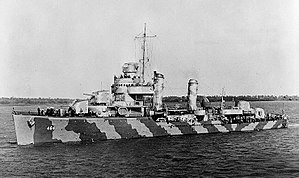 USS Hobson off Charleston, South Carolina, 4 March 1942. She is painted in camouflage Measure 12 (Modified). This photograph has been censored to remove radar antennas atop her foremast and Mark 37 gun director.
| |
| History | |
|---|---|
| Name | USS Hobson |
| Namesake | Richmond P. Hobson |
| Builder | Charleston Navy Yard |
| Laid down | 14 November 1940 |
| Launched | 8 September 1941 |
| Commissioned | 22 January 1942 |
| Reclassified | 15 November 1944 as Destroyer Minesweeper (DMS-26) |
| Fate | Sunk in collision with USS Wasp in the North Atlantic 26 April 1952. |
| General characteristics | |
| Class and type | Gleaves-class destroyer |
| Displacement | 1,630 tons |
| Length | 348 ft 3 in (106.15 m) |
| Beam | 36 ft 1 in (11.00 m) |
| Draft | 11 ft 10 in (3.61 m) |
| Propulsion |
|
| Speed | 37.4 knots (69 km/h) |
| Range | 6,500 nmi (12,000 km; 7,500 mi) at 12 kn (22 km/h; 14 mph) |
| Complement | 16 officers, 260 enlisted |
| Armament |
|
USS Hobson (DD-464/DMS-26), a Gleaves-class destroyer, was the only ship of the United States Navy to be named for Richmond Pearson Hobson, who was awarded the Medal of Honor for actions during the Spanish–American War. He would later in his career attain the rank of rear admiral and go on to serve as a congressman from the state of Alabama.
Hobson, constructed at a cost of $5 million, was launched at the Charleston Navy Yard on 8 September 1941; sponsored by Mrs. Grizelda Hobson, widow of Rear Admiral Hobson. As the new destroyer slid down the ways, she was cheered on by spectators and whistle blasts from other vessels on the Cooper River.[1] Hobson was commissioned on 22 January 1942.[2]
In 1952, Hobson collided with the aircraft carrier USS Wasp (CV-18) and sank with the loss of 176 crew. The ships had been undertaking amphibious exercises in the Atlantic, with Wasp practicing night flying, when Hobson attempted to turn in front of the carrier and collided with Wasp. Hobson was broken in two and quickly sunk, causing the greatest loss of life on a US Navy ship since World War II.
- ^ "Destroyer Launched at Charleston Yard". Los Angeles Times. 9 September 1941. p. 6.
- ^ Cite error: The named reference
DANFSwas invoked but never defined (see the help page).